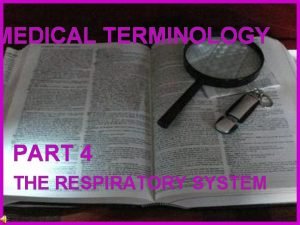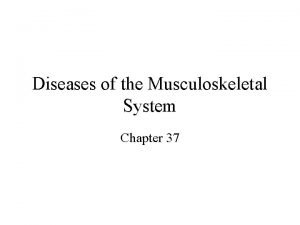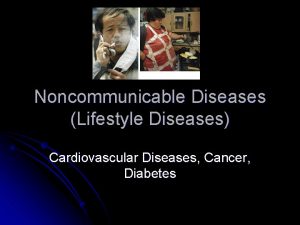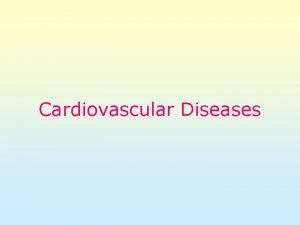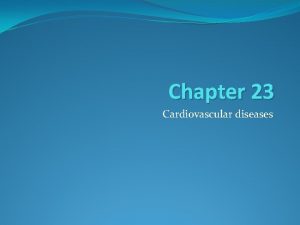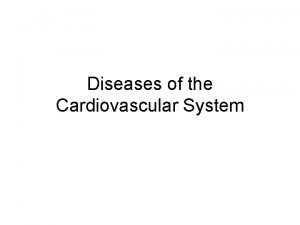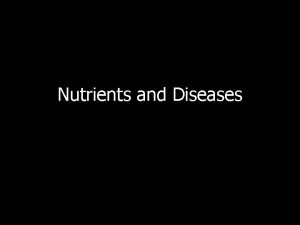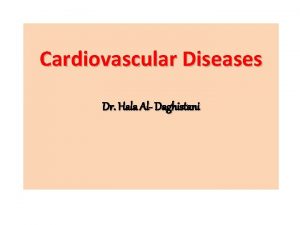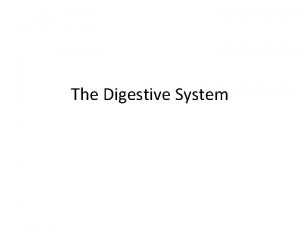Cardiovascular System and Diseases Cardiovascular system provides nutrients


















- Slides: 18

Cardiovascular System and Diseases Cardiovascular system provides nutrients and oxygen, carries away wastes, and help fight disease. Cardiovascular disease is a noncommunicable disease that affects the heart or blood vessel.

Functions of Cardiovascular System v Carrying oxygen from the lungs to body cells. v Absorbing nutrients from food and delivering nutrients to body cells. v Carrying carbon dioxide, a waste gas, from your cells back to your lungs to be exhaled. v Delivering other waste products to the kidneys for removal from the body. v Helping the white blood cells fight disease by attacking infectious organisms.

Human blood circulation ØPulmonary circulation: blood moves between the heart and the lungs. Blood that has lost oxygen and picked up carbon dioxide and wastes receives fresh oxygen in the lungs. The oxygen-rich blood is circulated again through the body. ØSystemic circulation: transports oxygenated blood away from the heart, to the rest of the body, and returns oxygen-depleted blood back to the heart. ØCoronary circulation: provides blood supply to the heart.

Heart v Four chambers: two top chambers are called the atria and the two lower chambers are called the ventricles. v A wall of tissue, the septum, separates the four chambers. v Valves between the atria and ventricles allow blood to flow through the chambers. v Top right atrium of am area of muscle that acts as a pacemaker. Electrical impulses stimulate the atria to contract, forcing blood into the ventricles. The electrical impulses travel through the heart to an area between the two ventricles and stimulate the muscles of the ventricles to contract, pumping blood out of the heart.


Blood q Made up of the following components: o Plasma: fluid in which other parts of the blood are suspended, is mainly water, but it also contains nutrients, proteins, salts, and hormones. o Red blood cells: contain hemoglobin, the oxygen-carrying protein in blood; hemoglobin contains iron that binds with oxygen in the lungs and releases the oxygen in the tissues, also combines with carbon dioxide which is carried from the cells to the lungs. o White blood cells : protect the body against infection. Some white blood cells surround and ingest the organisms that cause diseases. Some form antibodies and some fight against allergic reactions. o Platelets: types of cells in the blood that cause blood clots to form. When the wall of the blood vessel tears, platelets collect at the tear and release chemicals that stimulate the blood to produce small thread-like fibers that trap nearby cells and help to form a clot. The clot blocks the flow of blood and dries to form a scab.

Blood vessels § Arteries – carry oxygenated blood away from the heart. They branch into smaller vessels called arterioles which deliver blood to capillaries. § Capillaries – carry blood from arterioles and to small vessels called venules which empty into veins. They form a vast network throughout tissues and organs in the body, reaching almost all body cells. § Veins – return blood to the heart, are thinner and less elastic than those of the arteries. Many veins have valves that help prevent backflow of blood as it is pumped back to the heart.

Cardiovascular System Problems ü Congenital heart defects : conditions of ü Anemia: ability of the blood to carry heart that are present from the birth. May result from poor health of a baby’s mother during pregnancy. Medication and possibly surgery can help to repair the affected portion of the heart. Sometime heart transplantation is necessary. ü Leukemia: form of cancer in which white blood cells are produced excessively and abnormally. Causes the person to be susceptible to infection, severe anemia. Treatment include chemotherapy, radiation and bone marrow transplant. ü Varicose veins: formed as result of the valves in veins not closing tightly enough to prevent backflow of blood. oxygen is reduced. Blood may contain low numbers of red blood cells or low concentrations of hemoglobin. Most common cause id iron deficiency. ü Hemophilia: inherited disorder. Blood does not clot properly. Bruising and uncontrolled bleeding may occur spontaneously or due to injury. Treatment includes injections that introduce missing proteins into the blood. ü Heart murmurs: caused by a hole in the heart or leaking or malfunctioning valve.

Types of Cardiovascular diseases v Hypertension - high blood pressure o Damages the heart, blood vessels, and other body organs. o No symptoms “ silent killer”. o More common over the age of 35 o Treatment o Manage Weight o Adequate physical activity o Nutritious diet o Medications v Atherosclerosis o Disease characterized by accumulation of plaque on artery walls. o Suffers from arteriosclerosis, hardened arteries with reduced elasticity o Caused due to smoking, high blood pressure and high cholesterol level o Can lead to heart attack or stroke

Diseases of the Heart q Angina Pectoris • Chest pain that results when the heart does not get enough oxygen. • Lasts from few seconds to minutes. • It is a warning sign that your heart is not getting enough blood. • Caused by atherosclerosis • Treated by medications. q Arrhythmias • Irregular heartbeat that occurs when the heart skips a beat or beats very fast or very slowly. • Ventricular fibrillation- electrical impulses that regulate heart rhythm become rapid or irregular. • Treatment • Automated external defibrillator – device that delivers an electric shock to the heart to restore its normal rhythm. • Cardio pulmonary resuscitation - combines rescue breathing and chest compressions to supply oxygen to the body until normal body functions can resume.

Diseases of the heart Ø Heart Attack § Occurs due to insufficient blood supply to the heart. § Causes intense chest pain § Symptoms milder in women. § Warning signs § pressure, squeezing or aching in chest area § Pain spreads to arms, neck, jaw, abdomen or back § Shortness of breath, lightheaded feeling, sweating, nausea or vomiting. • Ø Congestive heart failure § Heart gradually weakens and can no longer maintain its regular pumping rate and force. § Can be improved through continuous treatment: medications and practicing healthy behaviors. Cannot be cured. § Heart transplant recommended, considered based on age, health concerns and willingness to make lifestyle changes.

Stroke o Acute injury in which blood flow to the brain is interrupted. o Artery supplying blood to the brain becomes blocked or bursts. o Cerebral hemorrhage is a stroke that occurs because of a burst blood vessels. o Impacts depends on the size of the stroke and what part is deprived of oxygen. May cause paralysis. o Warning signs o Severe headache o Numbness on one side of the body. o Confusion, dizziness. o Trouble walking. o Treatment: Clot buster drugs used to break up a clot and restore normal flow of the blood to brain.

Treatment Options q Coronary Bypass: Healthy vein is removed from another area to create a detour around blocked artery. q Angioplasty: Tube with balloon is inserted into blocked artery. Balloon is inflated against artery walls, then deflated and removed. Metal structure may remain to keep artery open. q Pacemaker: Implanted in chest. Sends electrical impulses to heart to make it beat regularly. q Laser Intervention: Laser fiber is inserted into blocked artery. Laser vaporizes the blockage and restores the flow of blood.

Diagnostic Tools Electrocardiogram(EKG) : produces graph of heart’s electrical activity. Shows heart function. Magnetic Resonance Imaging (MRI) : Uses powerful magnets to produce images. Shows heart damage and defects. Angiography: Thin, flexible tube guided through blood vessels to the heart. Dye is injected, and motion X- rays taken to look for heart obstructions. CT Scan: The patient lies on a table inside a doughnut-shaped machine. Scans create multiple images of the heart and show calcium blockages in arteries and vessels. They also show heart function.

Who does CVDs effect? Cardiovascular diseases can start to develop during adolescence or even childhood. Smoking, diabetics are more prone to develop cardiovascular diseases. Heredity: children whose parents have CVD may develop it themselves. Men have a greater risk than women. Older women are less likely than men of the same age to survive a heart attack. Risk increases with age.

Statistics Prevalence of CVD in adults age 20 and older by age and sex (NHANES 2003 -2006). Source: NCHS and NHLBI. These data include coronary heart disease, heart failure, stroke and hypertension.

Statistics CVD and other major causes of death: both sexes. (United States: 2006). Source: NCHS and NHLBI.

Risk Factors that can be controlled • Tobacco Use: Avoid using tobacco and secondhand smoke. • High Blood pressure: Check blood pressure regularly and eat healthy food, exercise regularly and manage your weight. • High Cholesterol: Eat fewer high-fat and high-cholesterol foods, and get regular physical activity. • Physical inactivity : Get at least 30 to 60 minutes of physical activity every day. • Excess Weight: Maintain a healthy weight. • Stress: Use stress management techniques. • Alcohol and Drug use: Abstain from alcohol and other drugs.
 Chapter 8 cardiovascular system
Chapter 8 cardiovascular system Chapter 6 musculoskeletal system
Chapter 6 musculoskeletal system Chapter 17 reproductive system diseases and disorders
Chapter 17 reproductive system diseases and disorders Chapter 15 nervous system diseases and disorders
Chapter 15 nervous system diseases and disorders 10 diseases of lymphatic system
10 diseases of lymphatic system Anatomy and physiology unit 7 cardiovascular system
Anatomy and physiology unit 7 cardiovascular system Voice box medical term
Voice box medical term Diseases of the musculoskeletal system
Diseases of the musculoskeletal system Sperm fructose
Sperm fructose Capillary bed
Capillary bed What makes up the cardiovascular system
What makes up the cardiovascular system Pithed rat model
Pithed rat model Its tubular dude
Its tubular dude Circulatory system crash course
Circulatory system crash course Medical terminology chapter 5 learning exercises answers
Medical terminology chapter 5 learning exercises answers Figure 11-9 is a diagram of the hepatic portal circulation
Figure 11-9 is a diagram of the hepatic portal circulation Figure 11-8 arteries
Figure 11-8 arteries Lesson 11 cardiovascular system
Lesson 11 cardiovascular system Lesson 11 cardiovascular system
Lesson 11 cardiovascular system






